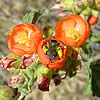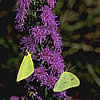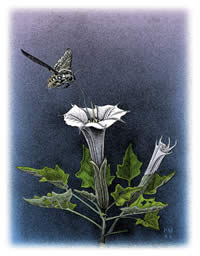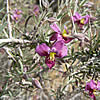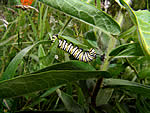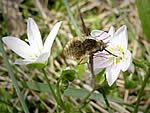USDA Forest Service Celebrating Wildflowers
|
|
|
Plant Pollination StrategiesFoodFun FactSome flowers produce two types of pollen: normal pollen that is involved in cross-pollination, and sterile pollen that is more appealing for the the pollinating insect to eat.
Fun FactSome plants produce a narcotic laced nectar that cause the pollinator to remain longer in the flower and to seek out other flowers of the same species. This prolonged pollination service better ensures successful transfer of pollen to the stigma. The majority of animals involved in pollination do so because the flower provides food in exchange for the pollination service. Food produced in the flowers may be nectar and/ or pollen. Nectar is primarily sugar water that also contains amino acids, minerals, and vitamins in concentrations best suited to meet the nutritional needs of the pollinator. Plants dependent on pollinators with high-energy diets such as hummingbirds produce copious amounts of nectar that have a much higher concentration of sugar and other nutrients as compared with other insect pollinated flowers. Pollen is high in protein and many bees and beetles eat it. Flowers dependent on insects that eat pollen produce large amounts of pollen to ensure successful pollination. Sacred Datura
Fun FactNectar and pollen are not the only rewards offered by flowers. Oil-collecting bees gather oils secreted by the glandular petals in the genus Krameria. These oils are made up of fatty acids and when mixed with pollen, are used as larval food by the bees. (Photo by Teresa Prendusi, US Forest Service.) Sacred Datura (Datura wrightii) has evolved a most ingenious floral strategy to ensure cross-pollination. The flowers of sacred Datura open at dusk. The flowers begin to unfold and then at the precise moment rapidly pop open and simultaneously release a powerful fragrance. The fragrant blossoms attract hawk moths. In this case of unusual pollination, the hawk moth enters the flower and lands on the corolla. Instead of hovering as hawk moths generally do, the moth proceeds to extend its very long proboscis down into the nectar canals. During this feeding, the hawk moth has been observed to beat its wings against the corolla. It is thought this behavior causes pollen to fall from the anthers and onto to the moth's head and other parts of its body. The hawk moth's head also rubs against the anthers that are at the tips of very long filaments. Pollination occurs when the hawk moth visits another flower and rubs up against the stigma at the tip of a very long style and pollen from its body sticks to the stigma. However, the unique adaptation of the sacred Datura to ensure a high-quality pollination service by the hawk moth is its production of narcotic nectar. This spiked nectar keeps the pollinator inside a blossom longer thereby enhancing the opportunity for collecting pollen from the anthers and depositing pollen on the stigma. The hawk moth becomes "addicted" to the nectar and thus almost exclusively visits only sacred Datura during its flowering season. These species of hawk moths have been observed arriving early and hovering about the sacred datura flowers at dusk waiting for the blossom to open so that they may get their "fix." Protective ChemistrySome plants provide chemicals that allow the insect pollinator to repel predators. Monarch butterfly larvae feed on milkweeds (Asclepias spp.). The latex sap in the leaves that the caterpillars eat contains a chemical that they incorporate into their bodies. This chemical defense protects them from a number of predator species. In many cases, the adult insect also pollinates the flower as it forages. |
|
| NOTE: PDF format links require the Adobe Acrobat Reader to view. | |
| top | Disclaimers | FOIA | Privacy Policy | Quality of Information | Photo Credits & Use |
Location: http://www.fs.fed.us/wildflowers/pollinators/plantstrategies/food.shtml
Last modified: Monday, 19-May-2008 14:02:14 EDT

